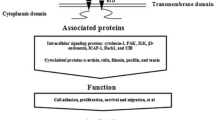Abstract.
Integrins, expressed on virtually every cell type, are proteins that mediate cellular interactions with components of the extracellular matrix (ECM) and cell surface integral plasma membrane proteins. In addition, integrins interact with the cytoskeleton and through this process participate in cell migration, tissue organization, cell growth, haemostasis, inflammation, target recognition of lymphocytes and the differentiation of many cell types. Signals generated from ligand-integrin interactions are propagated via the integrin cytoplasmic tails to signal transduction pathways within the cell (outside-in signalling). Information from within the cell can also be transmitted to the outside via integrin affinity modulation (inside-out signalling). Protein tyrosine phosphorylation has a central role in integrin-initiated cell signalling, leading to cytoskeletal organization and focal adhesion formation. This review will examine the current understanding of integrin function, focusing on the intracellular consequences of integrin-ligand interaction.
Similar content being viewed by others
Author information
Authors and Affiliations
Additional information
Rights and permissions
About this article
Cite this article
Longhurst, C., Jennings, L. Integrin-mediated signal transduction. CMLS, Cell. Mol. Life Sci. 54, 514–526 (1998). https://doi.org/10.1007/s000180050180
Issue Date:
DOI: https://doi.org/10.1007/s000180050180




